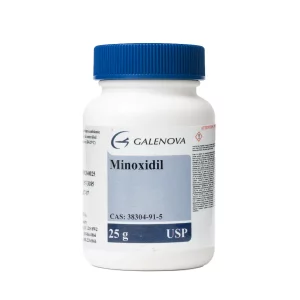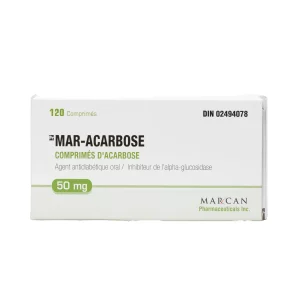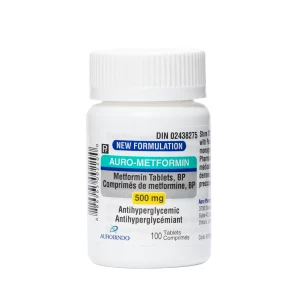Your cart is empty.
Your cart is empty.
Acarbose for longevity is gaining attention as research uncovers its potential beyond diabetes treatment. Studies comparing Acarbose vs Ozempic highlight unique benefits, while investigations into Acarbose cardiovascular benefits reinforce its role in healthy aging. For those considering this option, knowing where to Purchase Acarbose is essential.
Acarbose is a compound that interferes with carbohydrate digestion in the small intestine. By inhibiting enzymes that convert complex carbohydrates into glucose, it helps reduce post-meal blood sugar spikes. While originally developed for managing type 2 diabetes, acarbose has attracted interest in the field of aging science due to its unexpected effects on lifespan in preclinical studies.
Because elevated blood glucose contributes to oxidative stress and glycation, both implicated in cellular aging, researchers are now exploring whether acarbose might play a role in supporting healthy aging beyond glucose control.

Blood sugar spikes are known to accelerate aging through glycation, where sugar binds to proteins and forms harmful compounds called advanced glycation end products (AGEs). These byproducts contribute to cellular dysfunction and systemic inflammation.
By minimizing glucose surges, acarbose may help reduce glycation and related oxidative stress. These effects are linked to pathways involving improved insulin sensitivity, reduced inflammatory signaling, and enhanced cellular resilience, key factors in age-related health.
The Interventions Testing Program (ITP) by the National Institute on Aging conducted extensive studies examining acarbose’s effects on longevity in mice. These trials used genetically varied mouse populations and multi-site protocols for consistency.
Findings revealed increased median lifespan in male mice by approximately 16–17%, and 4–5% in females. While these results are promising, human longevity studies are ongoing and currently focus on surrogate aging markers such as inflammation, gut microbiome composition, and metabolic regulation.

Mouse models showed that early intervention with acarbose, starting around four months of age, produced notable gains in both median and maximum lifespan. In males, lifespan extended up to 22%, while 90th percentile survival improved by 8–11%. Female mice also showed measurable, though smaller, benefits.
These data suggest that acarbose may help more animals reach advanced ages, particularly males with elevated baseline glucose.
Human research is still in its early stages and centers on short-term indicators rather than lifespan. Current studies examine the compound’s effects on inflammatory markers, glucose stability, and gut microbiota over periods of 8–10 weeks in healthy older adults.
Some results show increases in microbial diversity and production of short-chain fatty acids, which are associated with gut health and systemic balance. Further investigation is required to determine the long-term implications of these shifts.
Acarbose influences several metabolic pathways linked to aging. By reducing glucose fluctuations, it supports improved insulin sensitivity and decreases inflammatory signaling. These outcomes can protect tissues from oxidative stress, a major contributor to aging-related degeneration.
It may also influence gut microbiota in ways that promote the production of beneficial compounds like butyrate, which support barrier function, immune modulation, and mitochondrial efficiency.
Preclinical studies have explored a range of acarbose intake levels, with benefits observed across moderate doses. Current research does not show clear superiority at higher levels, indicating a plateau effect.
In human investigations, researchers emphasize individualized tolerance and metabolic response over fixed protocols. Studies commonly evaluate intake in structured settings with monitoring, but all decisions around use and dosing are left to clinical discretion.
Metabolic shifts such as stabilized post-meal glucose and improved microbiome diversity can appear within several weeks. Improvements in inflammatory markers tend to emerge after 2–3 months.
However, long-term aging benefits require years of consistency and tracking. At present, human studies are designed to capture early aging signals, not lifespan outcomes.
Animal studies suggest a more pronounced benefit in males and subjects with elevated baseline glucose. Timing also matters, earlier intervention appears to result in stronger longevity outcomes.
That said, the benefit likely depends on a range of factors, including individual metabolism, genetics, and lifestyle. Favorable gut microbiota composition may also enhance response.
Acarbose may work synergistically with other approaches. In animal models, combining acarbose with caloric restriction or compounds like rapamycin produced greater lifespan gains than any intervention alone.
Nutrition strategies that support metabolic stability, such as Mediterranean-style diets, may further complement acarbose’s effects. Physical activity, known to modulate many of the same aging pathways, can also play a supportive role.
Despite encouraging animal data, human research remains limited in duration and scope. Lifespan studies take decades to complete and present logistical challenges, so surrogate markers are currently used to gauge potential benefits.
Open questions remain around sex differences, population variability, and ideal timing for intervention. More data are needed to clarify which individuals stand to gain the most.
Ongoing studies are expanding in size, duration, and diversity of participants. Researchers are employing advanced biomarker panels, cellular aging assays, and personalized omics analysis to refine outcome measures.
International efforts are also helping diversify study populations, improving our understanding of how genetic and environmental factors shape acarbose’s effects. Initial findings from long-term observational data may emerge over the next 5–10 years.
Although preclinical results are promising, acarbose’s role in human longevity is still being defined. Individuals interested in this research often monitor markers like glucose variability, gut health indicators, and inflammatory trends to evaluate effects over time.
Any decision to explore acarbose in a longevity context should be grounded in a broader wellness strategy, informed by individual health profiles and careful interpretation of evolving evidence.
Some early adopters have reported improved energy levels and greater post-meal comfort, alongside more stable glucose readings. These observations are subjective and vary widely between individuals.
Common self-monitoring tools include food timing, symptom tracking, and use of continuous glucose monitoring. Experiences are typically personalized and reflect individual response patterns.
Clinical trials generally use 25–100 mg with meals under supervision.
Early metabolic effects appear in 4-8 weeks; full longevity benefits require long-term use.
Lifespan extension is confirmed in animals; human data are still pending.
Use in healthy individuals should only occur under monitored clinical guidance.
Combining with caloric restriction, rapamycin, exercise, and gut-friendly diets shows added benefits.
Earlier use may be more effective, but individual factors determine suitability.
Harrison, D. E., Strong, R., Allison, D. B., Ames, B. N., Astle, C. M., Atamna, H., Fernandez, E., Flurkey, K., Javors, M. A., Nadon, N. L., Nelson, J. F., Pletcher, S., Simpkins, J. W., Smith, D., Wilkinson, J. E., & Miller, R. A. (2014). Acarbose, 17-α-estradiol, and nordihydroguaiaretic acid extend mouse lifespan preferentially in males. Aging Cell, 13(2), 273-282.
http://pubmed.ncbi.nlm.nih.gov/24245565/
Harrison, D. E., Strong, R., Astle, C. M., Flurkey, K., Nadon, N. L., Wilkinson, J. E., Frenkel, K., Carter, C. S., Pahor, M., Javors, M. A., Fernandez, E., & Miller, R. A. (2019). Acarbose improves health and lifespan in aging HET3 mice. Aging Cell, 18(2), e12898.
https://pubmed.ncbi.nlm.nih.gov/30688027/
Smith, B. J., Miller, R. A., Ericsson, A. C., Harrison, D. C., Strong, R., & Schmidt, T. M. (2019). Changes in the gut microbiome and fermentation products concurrent with enhanced longevity in acarbose-treated mice. BMC Microbiology, 19(1), 130.
https://pubmed.ncbi.nlm.nih.gov/31195972/
Strong, R., Miller, R. A., Antebi, A., Astle, C. M., Bogue, M., Denzel, M. S., Fernandez, E., Flurkey, K., Hamilton, K. L., Lamming, D. W., Javors, M. A., de Magalhães, J. P., Martinez, P. A., McCord, J. M., Miller, B. F., Müller, M., Nelson, J. F., Ndukum, J., Richardson, A. G., … Harrison, D. E. (2016). Longer lifespan in male mice treated with a weakly estrogenic agonist, an antioxidant, an α‐glucosidase inhibitor or a Nrf2‐inducer. Aging Cell, 15(5), 872-884.
https://pubmed.ncbi.nlm.nih.gov/27312235/
Strong, R., Miller, R. A., Bogue, M., Fernandez, E., Javors, M. A., Libert, S., Marinez, P. A., McCord, J. M., Miller, B. F., Pharaoh, G., Pletcher, S., Rainger, G. E., Richardson, A., Salomon, A., Macchiarini, F., & Harrison, D. E. (2020). Lifespan benefits for the combination of rapamycin plus acarbose and for captopril in genetically heterogeneous mice. Aging Cell, 19(12), e13269.
https://pubmed.ncbi.nlm.nih.gov/36179270/





Unlock savings on bundles and elevate your online experience today!